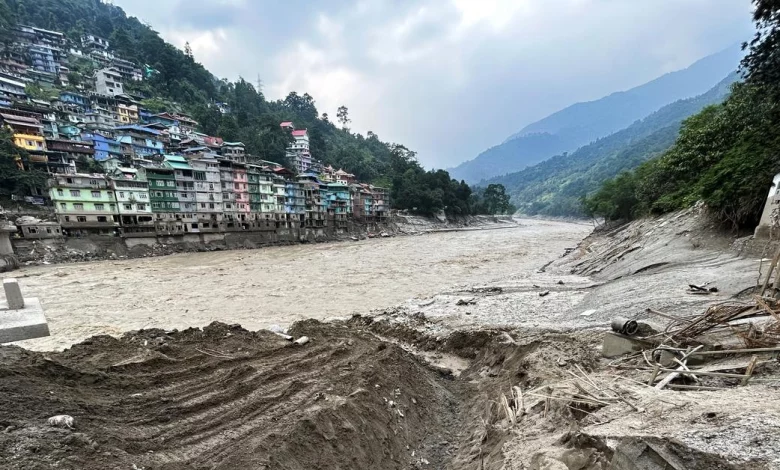Need for EIA in the Indian Himalayan Region
[GS Paper 3 - Conservation, Environment Pollution and Degradation]

Context – In light of the recent Teesta dam breach in Sikkim and floods in Himachal Pradesh, the potential negative impact of developmental activities on our ecology, especially in the mountains, is evident.
The recent Teesta dam breach in Sikkim and devastating floods and landslides in Himachal Pradesh have underscored the destructive consequences of our current development model. It is crucial to evaluate the environmental repercussions of significant human endeavors in order to strike a balance between development and ecological preservation.
Environment Impact Assessment (EIA)
- EIA, or Environment Impact Assessment, is a process defined by the United Nations Environment Programme (UNEP) to gauge the environmental, social, and economic impacts of a project before implementation.
- It contrasts various project alternatives, predicts environmental consequences, and suggests appropriate mitigation strategies.
- EIA provides data for informed choices that balance development with environmental concerns. It also identifies and mitigates potential environmental harm, promoting sustainable project designs.
- EIA’s public consultations enhance transparency and inclusive decision-making. It is a part of the legal framework for environmental protection, ensuring adherence to standards.
- EIA emphasizes long-term sustainability by assessing projects’ lasting impacts.
Challenges in the Indian Himalayan Region
- Climate Change: The Himalayas are particularly vulnerable to climate change. Rising temperatures have led to the melting of glaciers, affecting the flow of rivers and potentially impacting water availability for agriculture and drinking purposes.
- Deforestation and Biodiversity Loss: The region has been grappling with deforestation, illegal logging, and habitat degradation, leading to a decline in its unique biodiversity. Several species, including the iconic snow leopard, are threatened.
- Unplanned Development: The construction of hydropower projects, roads, and other infrastructure has often been haphazard, causing significant ecological and social disruptions. Landslides, floods, and other natural disasters have become more frequent due to such projects.
- Cultural and Social Impact: The region’s indigenous communities depend on the ecosystem for their livelihoods. Unplanned development can displace local communities and disrupt their traditional way of life.
- Water Security: The IHR is the source of several major rivers like the Ganges, Brahmaputra, and the Yamuna. Ensuring water security for the entire nation depends on the ecological health of this region.
Need for a Dedicated EIA
- Unique Ecology: The IHR’s ecology is distinct from the plains and other regions of the country. It hosts several species that are found nowhere else in India. Therefore, it’s imperative to assess the environmental impacts of any project in this region with specific reference to its unique biodiversity.
- Cultural Sensitivity: The diverse indigenous cultures in the IHR have intricate relationships with nature. Any development projects must consider the cultural and social implications unique to this region, which a specialized EIA can address.
- Geological Vulnerabilities: The Himalayan region is prone to seismic activity, landslides, and avalanches. A dedicated EIA can provide a more comprehensive assessment of the geological aspects and risks associated with any project.
- Hydroelectric Projects: Given the region’s significance in water resources, hydroelectric projects are common. However, they can have significant environmental consequences. A specialized EIA can better evaluate these consequences and suggest mitigation measures.
- Cumulative Impact Assessment: The Himalayan region is characterized by interconnected ecosystems. Development in one part can have cumulative effects on the entire region. A specialized EIA can facilitate a more thorough assessment of these cumulative impacts.
Implications of a Dedicated EIA for the IHR
- Improved Environmental Protection: A dedicated EIA for the IHR would ensure that environmental considerations are integrated into every developmental project. This would lead to better protection of the region’s ecology.
- Enhanced Cultural Preservation: Specialized EIAs would take into account the cultural and social aspects of the IHR, ensuring that development respects and preserves the unique traditions and livelihoods of indigenous communities.
- Scientific Rigor: The region’s geological vulnerabilities require in-depth scientific studies. A specialized EIA can bring in the necessary scientific rigor for accurate assessments and risk analyses.
- Better Mitigation and Monitoring: Specialized EIAs would provide region-specific mitigation measures and comprehensive monitoring to ensure that environmental impacts are minimized and addressed promptly.
- Public Participation: A dedicated EIA can encourage public participation and consultation in the region, ensuring that local voices are heard and taken into consideration during the planning and execution of projects.
- Adaptation to Climate Change: The Himalayan region is already experiencing the impacts of climate change. A specialized EIA can integrate adaptation strategies into development projects to make them more resilient to changing environmental conditions.
Conclusion
The Indian Himalayan Region is a treasure trove of ecological and cultural diversity. Preserving this unique heritage is not just a regional concern but a national imperative. The introduction of a specialized Environmental Impact Assessment for the IHR is a significant step in the right direction. It can provide a more comprehensive and context-specific evaluation of the environmental, social, and cultural impacts of developmental projects in the region. Moreover, it can ensure that the delicate balance between development and conservation is maintained, securing the future of this remarkable region for generations to come. It is essential that this proposal receives the attention and support it deserves to ensure the long-term sustainability of the Indian Himalayan Region.
SOURCE: The Hindu
Practice question:
Q. What do you mean by the carrying capacity of the environment.





.png)



